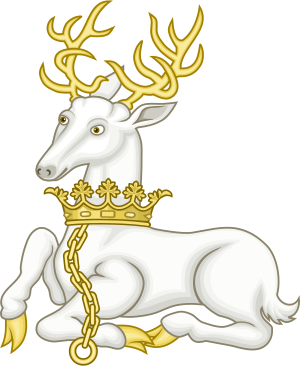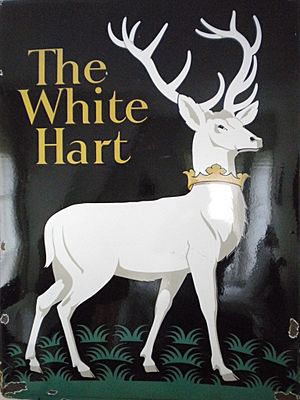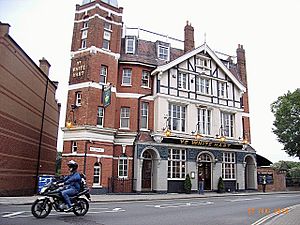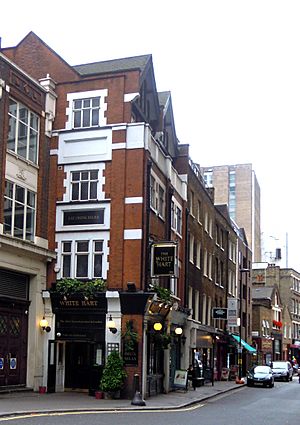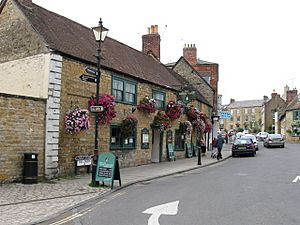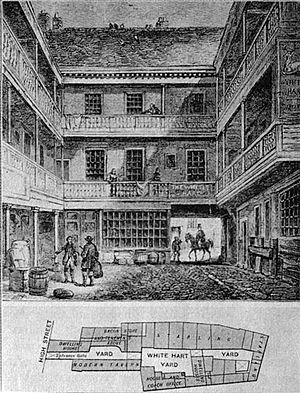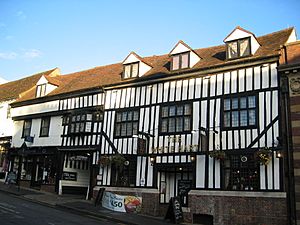White Hart facts for kids
The White Hart is a special symbol. A "hart" is an old word for a grown-up male deer, also called a stag. This white deer was the personal badge of King Richard II. He likely got this symbol from his mother, Joan "The Fair Maid of Kent". Some people also think it was a clever play on his name, sounding like "Rich-hart."
In a famous painting called the Wilton Diptych, King Richard II wears a beautiful jewel of a gold and white hart. Even the angels around the Virgin Mary in the painting wear white hart badges. In old English Folklore, the white hart is linked to a mythical figure called Herne the Hunter.
Today, many inns and pubs in England are still named "The White Hart." It is one of the most popular names for pubs.
The famous science fiction writer Arthur C. Clarke wrote a collection of stories called Tales from the White Hart. These stories were told as if people were drinking in a fictional pub named "The White Hart." This pub was located somewhere between Fleet Street and the Embankment in London. The fictional pub was based on a real one called "The White Horse." This was a place where London's science fiction fans used to meet in the 1940s and 1950s.
Contents
- Famous White Hart Inns in Britain
- Barnes, London
- Bletchingley
- Braintree
- Brentwood
- Canterbury
- Coggeshall
- Colyford
- Crawley
- Dartington, Totnes
- Edinburgh
- Hampshire
- Henfield
- Hingham
- Hull
- Isle of Wight
- Llangybi
- London (Drury Lane)
- Mitcham, London
- Ringwood
- Rowen, Conwy
- Shifnal, Shropshire
- Sherborne, Dorset
- Sonning-on-Thames
- South Mimms
- Southwark, London
- St Albans
- St Keverne
- Thatcham, Berkshire
- Wilmington
- Witham
- Witley
- White Hart Inns in America
- See also
Famous White Hart Inns in Britain
Many old pubs across Britain are named "The White Hart." Here are some of the most well-known ones.
Barnes, London
"Ye White Hart" in Barnes is a Victorian-era pub. It offers great views of the Thames River. This pub is a well-known spot during the famous Boat Race. In the mid-1800s, it was even the main meeting place for the Barnes Football Club.
Bletchingley
The Whyte Hart Hotel in Bletchingley is believed to have started in 1388. It was shown in a 1958 Pathé News film. This film highlighted old cooking styles and dishes still used at the hotel.
Braintree
The White Hart Hotel in Braintree has been around since the 14th century. It was built at the crossing of two old Roman roads. These roads now form the center of Braintree town. It used to be a coaching inn. This means it offered services for horse-drawn coaches traveling to Sudbury and Norwich every day. This continued until the railway arrived in 1848. The hotel has recently been updated by its current owners.
Brentwood
The White Hart in Brentwood is the oldest pub in the town. It dates back to before 1480. It might have been named after King Richard II. He passed through Brentwood in 1392 and possibly stayed at the inn. In the 18th century, it became a coaching inn. By 1910, it even offered repairs for early motor vehicles. Today, the building is a nightclub and restaurant called Sugar Hut. You can see the building on the reality TV show, 'The Only Way Is Essex'.
Canterbury
The front of The White Hart in Canterbury looks Victorian. However, it is thought to be built on the site of an old church. This church, St Mary de Castro, was taken down around 1486. The pub's cellar is believed to be the church's old mortuary. It even has a chute that was used for bodies. The small park next door was the church graveyard. The pub also has a nice garden.
Coggeshall
The White Hart Inn at Coggeshall is in a charming market village. It sits on the route between Braintree and Colchester. This inn dates back to 1420. It still has many of its original features. These include timber rooms that can house up to 18 beds. There is also a large meeting room available to rent.
Colyford
The White Hart Inn in Colyford is located on the A3052 road. This road runs along the south coast from Bridport to Exeter.
Crawley
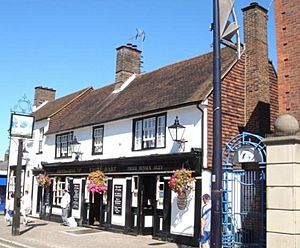
Crawley became an important stop for coaching after the London to Brighton road was improved in 1770. By 1668, an old house from the mid-1400s was turned into an inn called The Whyte Harte. This name later became The White Hart. More coaching traffic in the late 1700s meant the inn was often too full. So, it was sold in 1753. The money was used to build a new White Hart Inn nearby. This new inn opened in 1770. As of 2011, it still operates as The White Hart. It is owned by Harveys Brewery.
Dartington, Totnes
The White Hart is a bar and restaurant inside the Dartington Hall estate. This estate is near Totnes in Devon. The medieval Dartington Hall was built for John Holand, Earl of Huntingdon. He was also the half-brother of Richard II of England. The Dartington Morris Men dance group was formed at Dartington Hall in 1968. They were allowed to use the white hart symbol on a red rose as their emblem.
Edinburgh
In Edinburgh, "The White Hart" is an inn in the Grassmarket area. It was established in the early 16th century. It was popular among people watching public events. Famous visitors included Robert Burns and William Wordsworth.
Hampshire
There are several White Hart pubs along an old main road. This road used to go from London to Salisbury. You can find these pubs in places like Hook, Basingstoke, Worting, Overton, Whitchurch, Andover, Stockbridge, Gosport, and Salisbury.
Henfield
The White Hart pub in Henfield, West Sussex, was built in 1777. It is located next to the A2037 road, which connects Worthing and London.
Hingham
The White Hart in Hingham, Norfolk is a boutique hotel and gastropub in the town center.
Hull
"The Olde White Harte" in Silver Street, Kingston upon Hull, was built around 1660. It was redesigned in 1881 to look like a romantic 17th-century inn. The outside has a special style called Artisan Mannerist. The inside has a lot of wood paneling, some from the 17th century. The building is a Grade II* listed building, meaning it's very important. A local story, likely from the 1800s, connects the building to Sir John Hotham, 1st Baronet. It is said that in the "Oak Room," Sir John Hotham decided to stop King Charles I from entering the town. This led to the First Siege of Hull during the English Civil War.
"The White Hart" on Alfred Gelder Street, Kingston upon Hull, was built in 1904. The poet Philip Larkin often visited this pub. In 1977, he gave a talk there called ‘My Life and Death as a Record Reviewer’.
Isle of Wight
The White Hart in Havenstreet is near the main center of the Isle of Wight Steam Railway. Because of this, it has a railway theme.
Llangybi
The White Hart in Llangybi was first built in the early 1500s. It later became the property of Henry VIII. This happened as part of his wife Jane Seymour's wedding dowry. About a hundred years later, Oliver Cromwell is believed to have used it as his headquarters in Monmouthshire during the English Civil War. The inside of the pub still has 11 fireplaces from the 17th century. It also has many exposed beams, original Tudor period plasterwork, and even a secret priest hole.
For many years, students of English literature were puzzled by two lines in a poem called 'Usk' by T.S. Eliot. In 2003, The Guardian newspaper reported that T. S. Eliot was referring to this pub in his poem. He was not talking about an animal. The poet visited this old inn in 1935 while touring Wales. The pub does stand near the village well, which was once painted white but is now in ruins.
London (Drury Lane)
The White Hart at 191 Drury Lane has been around since the 15th century. Drury Lane is one of central London's most famous streets.
Mitcham, London
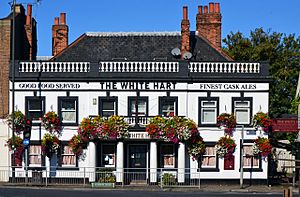
The White Hart in Mitcham is an 18th-century building. It is currently closed but is a listed building. It is located near Mitcham Cricket Green. This was Mitcham's first recorded inn. It was rebuilt in 1749-50 after a fire. The central porch has a decorative band and a railing. It is supported by four Tuscan columns. Stagecoaches used to start from a yard at the back of the inn. It is a Grade II listed building. It is on London Road.
Ringwood
The White Hart at Ringwood in the New Forest is said to be the first pub with this name. A story says that King Henry VII caught a white hart nearby. He then put a leash on it and led it back to the town in triumph. This legend might have a hidden political meaning.
Rowen, Conwy
White Hart Road is the name of a road section in the Conwy Valley. It is high above the village of Rowen. This road was planned as a new part of the Royal Mail coach road. It was meant to connect Llanbedr y Cennin to Abergwyngregyn. This was before the A55 coast road was built. The old records still show the name White Hart for this road, which is unusual for a road name.
Shifnal, Shropshire
The White Hart in Shifnal is a timber-framed building. It dates back to the 18th century, with parts added later. It was named CAMRA Telford Pub of the Year in 2017, 2018, and 2019.
Sherborne, Dorset
There is a long-established pub called the White Hart on the main street in Sherborne.
Sonning-on-Thames
The Great House at Sonning in Sonning, Berkshire, is on the banks of the River Thames. It used to be called the White Hart. This was because King Richard II's wife, Isabella of Valois, was held captive in the village after his death.
South Mimms
The White Hart, South Mimms in Hertfordshire is a Grade II listed pub. It was built in the late 17th or early 18th century.
Southwark, London
An inn called the "White Hart" was set up in the medieval period. It was on Borough High Street in Southwark, just south of London Bridge. William Shakespeare mentions it in his play Henry VI, Part 2. In the play, it is the headquarters for the rebels in Jack Cade's 1450 Kentish rebellion. Louis L'Amour also mentions the Southwark White Hart in his historical fiction book "Sackett's Land." This book takes place around 1600. It became one of the many famous coaching inns during the time of Charles Dickens. It was here that Sam Weller met Mr. Pickwick in a famous scene from The Pickwick Papers, chapter 10. The inn was torn down in the 19th century. It was next door to The George Inn.
Also in Southwark, about half a kilometer to the west, is the White Hart at 22 Great Suffolk Street. It was built in 1882. It survived when the area around it was redeveloped. Now, it is the only Victorian pub on that street.
St Albans
The "White Hart" in St Albans is a former coaching inn. It is also a Grade II* listed building. It is listed in CAMRA's Register of Historic Pub Interiors.
St Keverne
The "White Hart" in St Keverne, Cornwall, was the birthplace of the singer and actor Charles Incledon in 1764.
Thatcham, Berkshire
The White Hart in Thatcham is mentioned in a book called Coaching Days and Coaching Ways (1888) by W. Outram Tristram.
Wilmington
The White Hart in Wilmington, East Devon, is on the A35 road. This road runs between Honiton and Axminster. There was also a White Hart in Axminster in the 1800s.
Witham
The White Hart Inn in Witham, Essex, is in the north center of the town. It has been there since the late 13th century. Located at the top of Newland Street, it is one of the many old buildings in the town. Since 2006, it has been renovated to look like its original, authentic state.
Witley
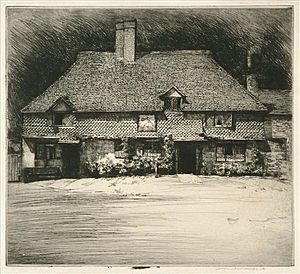
The White Hart is the village pub in Witley, Surrey. Most of it is from the Elizabethan era. It is said to stand on the site of an old Anglo-Saxon inn. It is believed to have one of the oldest continuous licenses for a pub in England. The artist Myles Birket Foster painted the picture-board for it around 1875. This painting is now in the Victoria and Albert museum in London.
White Hart Inns in America
Salisbury, Connecticut
The White Hart Inn in Salisbury, Connecticut is named after one of the pubs in Hampshire, England. It has been an inn since 1867. However, parts of the building were built in 1806 as a private home. It has a dining room, a pub, and many guest rooms. These are in the main building and the nearby Gideon Smith House. The inn closed in November 2010 and was for sale. In May 2014, an investor group bought the inn for $2.9 million. This group was led by Thomas Conley Rollins Jr. They reopened the property in 2014. The inn has 16 guest rooms, three dining rooms, a taproom, and two outdoor dining areas. It also has a large porch with drink service, a ballroom, and a café. Art by famous artists like Jasper Johns and Frank Stella is displayed throughout the inn.
See also
- Heart (band), a music band that was first called White Hart
- White stag, a type of deer
- White boar, another animal symbol


